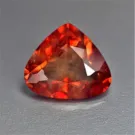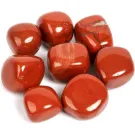Red gemstone caught civilizations for centuries, symbolizing passion, strength, and energy. Their brilliant colors range from lightning oranges to deep red, with each one unique in terms of rarity and value. These precious stones are discovered in different parts of the world, from the rich coral reefs of the Mediterranean to the rugged mountain mines of Myanmar.
A
| Gemstone | Origins | images |
|---|---|---|
| Almandine Garnet | Sri Lanka, India, Madagascar, Brazil, USA |  |
| Andesine Labradorite | Mongolia, Africa |  |
| Andesine | Congo, Tibet, Mongolia |  |
B
| Gemstone | Origins | images |
|---|---|---|
| Bixbite (Red Beryl) | USA |  |
| Bloodstone (Heliotrope) | India, Australia, Brazil, USA |  |
C
| Gemstone | Origins | images |
|---|---|---|
| Carnelian | India, Brazil, Egypt, Uruguay, USA |  |
| Coral | Mediterranean Sea, Japan, Taiwan |  |
E
| Gemstone | Origins | images |
|---|---|---|
| Eudialyte | Russia, Greenland, Canada |  |
F
| Gemstone | Origins | images |
|---|---|---|
| Fire Opal | Mexico, Ethiopia, Australia, USA |  |
G
| Gemstone | Origins | images |
|---|---|---|
| Garnet | India, Sri Lanka, Brazil, Tanzania |  |
H
| Gemstone | Origins | images |
|---|---|---|
| Hessonite Garnet | Sri Lanka, India, Brazil, Tanzania, Madagascar |  |
J
| Gemstone | Origins | images |
|---|---|---|
| Jasper | India, Brazil, Madagascar, USA |  |
O
| Gemstone | Origins | images |
|---|---|---|
| Ox Blood Coral | Mediterranean Sea, Japan |  |
P
| Gemstone | Origins | images |
|---|---|---|
| Pezzottaite | Madagascar, Afghanistan |  |
| Pyrope Garnet | USA, South Africa, Tanzania, Czech Republic |  |
R
| Gemstone | Origins | images |
|---|---|---|
| Red Diamond | Australia, Brazil, Russia |  |
| Red Spinel | Myanmar (Burma), Sri Lanka, Vietnam, Tanzania, Afghanistan |  |
| Ruby | Myanmar (Burma), Thailand, Mozambique, Sri Lanka, Madagascar |  |
S
| Gemstone | Origins | images |
|---|---|---|
| Spessartite Garnet | Namibia, Nigeria, Madagascar, Sri Lanka, Brazil |  |
| Sard | India, Brazil, Germany, Russia |  |
T
| Gemstone | Origins | images |
|---|---|---|
| Thulite | Norway, Sweden, USA |  |
Z
| Gemstone | Origins | images |
|---|---|---|
| Zircon | Sri Lanka, Cambodia, Myanmar, Tanzania |  |
Almandine Garnet
Description: Almandine garnet is a deep red gemstone with a slight violet tint. It is part of the garnet family and is known for its durability and brilliance.
History and Origins: This garnet was named after the ancient city of Alabanda in Asia Minor, where it was first discovered. Garnets have been used since antiquity in jewelry and carvings.
Mines: Found in India, Sri Lanka, Madagascar, and Brazil.
Value: Its intense color and affordability make it a popular choice in jewelry.
Andesine-Labradorite
Description: A red to orange variety of feldspar, Andesine is a relatively modern addition to the gemstone world.
History and Origins: This gemstone gained attention in the early 2000s. The name “Andesine” comes from the Andes Mountains, where it was initially thought to be found.
Mines: Predominantly found in China and Congo.
Value: Its unique hues and shimmering effect, known as aventurescence, add to its appeal.
Bixbite (Red Beryl)
Description: Known as the “red emerald,” Bixbite is one of the rarest gemstones in the world. Its vibrant red color is unmatched.
History and Origins: Named after Maynard Bixby, who discovered it in the early 1900s.
Mines: Found only in Utah, USA, specifically in the Wah Wah Mountains.
Value: Its rarity and brilliant hue make it incredibly valuable, often fetching higher prices than diamonds.
Bloodstone
Description: A dark green chalcedony with red spots resembling blood.
History and Origins: The name comes from ancient legends that claimed the stone formed from the blood of Christ. It was often used in religious artifacts.
Mines: Found in India, Brazil, and Australia.
Value: Its unique appearance and spiritual significance make it a favorite for collectors.
Carnelian
Description: Carnelian is a translucent reddish-orange chalcedony that has been cherished for centuries.
History and Origins: Ancient Egyptians called it the “setting sun stone” and used it in talismans and jewelry.
Mines: Found in Brazil, India, and Uruguay.
Value: Affordable and widely available, but prized for its historical significance.
Cuprite
Description: Cuprite is a metallic red gemstone, more often kept as a collector’s piece than used in jewelry due to its softness.
History and Origins: Its name comes from the Latin word cuprum, meaning copper, as it is a copper oxide mineral.
Mines: Found in Namibia, Congo, and Arizona, USA.
Value: Its rarity and striking red color appeal to mineral collectors.
Eudialyte
Description: Eudialyte is a pinkish-red to dark crimson gemstone that is rarely used in jewelry.
History and Origins: The name originates from the Greek words eu (well) and dialytos (decomposable), referring to its chemical composition.
Mines: Found in Russia, Canada, and Greenland.
Value: Known for its rarity and distinctive color.
Fire Opal
Description: A fiery orange-red gemstone that can range from translucent to transparent.
History and Origins: The Aztecs revered it as the “Stone of the Bird of Paradise.” Its name comes from its flame-like appearance.
Mines: Found mainly in Mexico.
Value: Valued for its vibrant color and play of light.
Garnet (General)
Description: Garnets are deep red gemstones that have been used for over 5,000 years.
History and Origins: The name comes from the Latin granatus, meaning “seed,” as garnets resemble pomegranate seeds.
Mines: Found worldwide, including India, Sri Lanka, and Africa.
Value: Garnets are affordable yet elegant, making them highly sought after.
Hessonite Garnet
Description: A warm red to orange-brown garnet variety.
History and Origins: Known as the “cinnamon stone” due to its rich color.
Mines: Found in Sri Lanka, India, and Tanzania.
Value: Its unusual color and affordability make it a favorite among garnet lovers.
Jasper (Red)
Description: Jasper is an opaque red chalcedony that is commonly used in beads and carvings.
History and Origins: The name comes from the Greek word iaspis, meaning spotted stone.
Mines: Found in the USA, Australia, and South Africa.
Value: Its affordability and versatility make it widely used in jewelry.
Pigeon’s Blood Ruby
Description: A term used for the most vivid red rubies, resembling the color of a pigeon’s blood.
History and Origins: The term originated in ancient Burma (Myanmar), where rubies have been mined for centuries.
Mines: Primarily found in Myanmar, Mozambique, and Sri Lanka.
Value: Among the most valuable gemstones due to their exceptional color.
Red Spinel
Description: Often mistaken for ruby, red spinel is a brilliant gemstone in its own right.
History and Origins: Many famous “rubies” in history, like the Black Prince’s Ruby, were later identified as spinels.
Mines: Found in Myanmar, Sri Lanka, and Vietnam.
Value: Its rarity and historical importance increase its value.
Rhodolite Garnet
Description: A purplish-red variety of garnet.
History and Origins: The name comes from the Greek rhodon, meaning rose-like, due to its color.
Mines: Found in Tanzania, Sri Lanka, and India.
Value: Loved for its unique color and affordability.
Tourmaline (Rubellite)
Description: A pink to red variety of tourmaline.
History and Origins: The name comes from the Sinhalese word turamali, meaning “mixed stones.”
Mines: Found in Brazil, Nigeria, and Madagascar.
Value: Its vibrant hue and rarity make it highly prized.
Zircon (Red)
Description: A red variety of zircon, distinct from cubic zirconia.
History and Origins: The name comes from the Persian zargun, meaning “gold-colored.”
Mines: Found in Cambodia, Myanmar, and Sri Lanka.
Value: Loved for its brilliance and affordability


3 comments
This online pharmacy offers an extensive variety of medications at affordable prices.
Shoppers will encounter all types of drugs suitable for different health conditions.
We work hard to offer high-quality products while saving you money.
Quick and dependable delivery ensures that your medication gets to you quickly.
Experience the convenience of shopping online through our service.
https://articles.abilogic.com/714340/taking-next-level-how-fildena.html
What a data of un-ambiguity and preserveness of precious familiarity about unpredicted feelings.
On this platform, you can access a wide selection of casino slots from leading developers.
Visitors can enjoy retro-style games as well as feature-packed games with high-quality visuals and interactive gameplay.
Even if you’re new or a casino enthusiast, there’s always a slot to match your mood.
casino slots
All slot machines are instantly accessible round the clock and optimized for PCs and mobile devices alike.
You don’t need to install anything, so you can jump into the action right away.
Platform layout is intuitive, making it simple to explore new games.
Join the fun, and dive into the thrill of casino games!